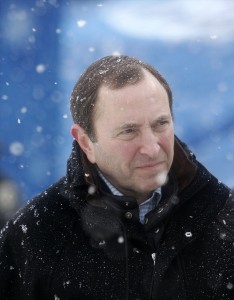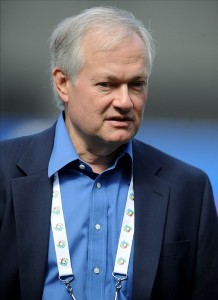
On a frosty Friday in New York City, Federal Mediation and Conciliation Service’s Deputy Director, Scot Beckenbaugh, spent the majority of the day running between separate meetings with the NHL and the NHLPA in different buildings.
Many have questioned if this is even worthwhile, since the league and players are no longer sharing the same isolated room for hours on end trying to hammer out an agreement. If that wasn’t enough to cast doubt on the situation for many, the fact that mediation has failed to solve this lockout and the lockout that resulted in the cancellation of the 2004-2005 NHL season, remains present in the mind of many NHL fans.
Although the players and league did not meet to discuss a new CBA together on Friday, more real progress will have been made on this day than in any previous negotiation session, and it will result in the end of the NHL lockout.
Relationship-by-Objective (RBO)
When it appeared that all hope was lost in the NHL and NHLPA coming to an agreement after the NHLPA failed to execute a disclaimer of interest and talks broke off, seasoned mediator Scot Beckenbaugh stepped in to help put the process back on track.
When negotiation talks have deteriorated to a critical stage and it seems that all trust has evaporated between the two parties, the mediator’s job is no longer solely focused on getting the groups in a room to discuss an agreement, but to rebuild a relationship based on the end result. In mediation terms, this strategy is typically referred to as Relationship-by-Objective or RBO.
The main goal of Relationship-by-Objective is to refocus the talks on solving the negotiation by finding common objectives, as opposed to trying to negotiate specific items of a contract. For example, instead of attempting to get the players and league to agree to a specific figure on a salary cap for the 2013-2014 season without meeting in person, Beckenbaugh has most likely spent the time listening to each side to determine other areas where they still agree and then uses that common ground to build upon. In other words, if the owners don’t trust the players and the players don’t trust the owners, they both may be able to trust an independent mediator, as well as agree that the main goal of the process is a Collective Bargaining Agreement that helps grow the league, while providing sufficient protection to the players.

The leading reason most negotiations turn sour and find themselves confronted with a mediator, or even an arbitrator, is that each side feels that the other side has stopped actively listening to what they are trying to accomplish.
In previous negotiation sessions, when mediation accomplished little, the players and the league were still posturing for better leverage in the talks and were probably trying to use mediation to gain media or public support, instead of discussing specific goals and an endgame. The circumstances have changed and although talks have broken off as a result of a loss of trust, in addition to an increase in legal activity, the progress made in past discussions this week has resulted in an imaginable resolution to the lockout for both sides.
Ultimately, the objective of RBO for both parties is to identify specific problem areas, develop mutual problem solving techniques to address these issues, and timetables for their resolution.
Relationship-by-Objective is widely viewed by mediators as not only a way to help solve short-term labor disputes, but also to provide labor and management parties with a stronger working relationship in the future to hopefully avoid further conflicts.
Beckenbaugh’s Exhausting Day
The first phase of Beckenbaugh’s tried and tested plan is to get the two parties to discuss, in-depth, the problems they are experience in negotiations currently, what they would like to see happen in negotiations, and what the ideal deal would look like for them and where they could possible show flexibility.
The FMCS Deputy Director most likely spent a good portion of his time on Friday meeting with both the NHL and the NHLPA individually to find out from each side why they think negotiations were halted.
The NHL most likely started by describing the pains that they have experienced attempting to negotiate with Donald Fehr, someone they perceive more as a diabolical strategist than a good-faith negotiator. At the same time, the NHLPA probably defined the league as a manipulative negotiating partner, only concerned with lining their own pockets, even at the expense of the product and the players.
Next, Beckenbaugh would have worked through what their expectations are from negotiations to help ensure that both parties are still committed to an agreement that would actually resolve the conflict.
With the discussion about the obstacles facing negotiations out of the way, the parties can concentrate on where they see negotiations heading and what they could do to help get it there. For the NHLPA, this means holding off on executing a Disclaimer of Interest and for the NHL, it means ensuring that legal action as leverage is no longer perceived as a viable negotiation tactic.
Once both parties agree to what basically amounts to cease-fire of threats, the mediator will start to discuss with each side what they see as a potential resolution to the conflict. This can include everything from timetables, expectations of further negotiations, and a final resolution. Although most mediators will keep what is discussed in private sessions confidential, unless advised otherwise by the parties, this exercise helps the mediator to understand the mindset of the two parties, how they differ, and where they may be able to find common ground. During this part of the private sessions, Beckenbaugh probably discovered that the NHL and NHLPA both still seek a resolution other than cancelling the season and that on many of the key issues have already come to an agreement, but that other issues have become more contentious, such as pensions, the second year salary cap, and escrow.
Although Beckenbaugh would have most likely received specific figures from each side, it is rare for mediators to attempt to directly negotiate a contract at this phase without also attempting to bring the sides together to meet with each other.
By discovering where each side was positioned and where they may have some flexibility, Beckenbaugh probably assisted each side in developing a timetable for how they would like to see the negotiations play out over the next week. Once the NHL and NHLPA have created a timeline for the rest of negotiations, Beckenbaugh would then seek to set up a meeting with the two parties, but only after another brief meeting between each party and the mediator to ensure that talks resume smoothly.
So even though talks between the NHL and NHLPA might resume Saturday, each party can be expected to meet with Beckenbaugh beforehand. In order to resume talks, the parties must mutually decide to do so, as the mediator will not attempt to force the sides back to negotiations prior to when they appear ready.
In 2010, after a threat of a strike by the Major League Soccer Players Union, both sides agreed to bring in FMCS to help mediate the dispute, including Scot Beckenbaugh. In the attached video, you’ll hear both the MLS and the players union talk about the mediation process and some of the familiar circumstances surrounding the NHL lockout.
With a focused, objective-based approach, aided by a mediator that both sides trust, the NHL lockout will finally conclude, without having to become the first North American professional sport to lose a second season to a labor dispute.
The lack of direct discussions may supply fans and the media with a reason to despair, but Scot Beckenbaugh’s trusted Relationship-by-Objective mediation technique will help create a much smoother partnership between the NHL and the union that represents its players that will not only end the lockout, but hopefully help prevent future ones.